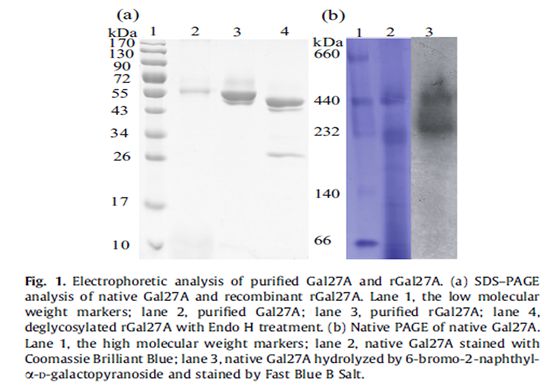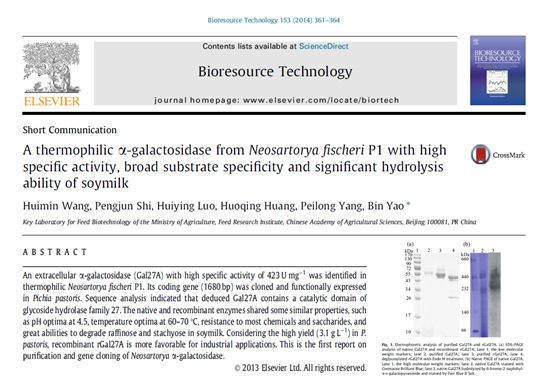分享到
FRI researchers build novel α-galactosidase resources
α-Galactosidase has the hydrolysis ability to catalyze the breakage of α-D-galactoside bond and transglycosylation activity, and it is widely used in the feed, medicine, food and chemical industries. To alleviate the anti-nutritional effect of galactooligosaccharides (GOS) in soybean meal and promote animal health, α-galactosidase is generally supplemented in the feed stuff. Due to the high cost, low yield, and the rmoliability under high-temperature feed processing conditions limited the application of α-galactosidase.

Dr. Yao bin, senior scientist of Feed Research Institute (FRI), Chinese academy of agricultural sciences (CAAS), led the enzymetic engineering research team to work on α-galactosidase and to clone novel α-galactosidase genes from the rmophilic microorganisms, to construct high-yield secretory engineering strains, and to provide cost-effective α-galactosidase candidates with excellent properties and high productivity for potential industrial application.

By the enzyme protein purification and gene cloning, six novel α-galactosidases from the rmophilic microorganisms were obtained with potential application. And, two different structure GH27 α-galactosidases degradation on guar galactomannan with different degrees of galactose substitution (21- 38%) and konjac galactomannan, was studied and laying the foundation for substrate specificity of GH27 α-galactosidase , enriching the α-galactosidase genetic resources, and providing a good materials for research and industrial applications.
The research has been published in The Bioresource Technology. More details are available the links bellow:
http://www.sciencedirect.com/science/article/pii/s096085241301804X.

Dr. Yao bin, senior scientist of Feed Research Institute (FRI), Chinese academy of agricultural sciences (CAAS), led the enzymetic engineering research team to work on α-galactosidase and to clone novel α-galactosidase genes from the rmophilic microorganisms, to construct high-yield secretory engineering strains, and to provide cost-effective α-galactosidase candidates with excellent properties and high productivity for potential industrial application.

By the enzyme protein purification and gene cloning, six novel α-galactosidases from the rmophilic microorganisms were obtained with potential application. And, two different structure GH27 α-galactosidases degradation on guar galactomannan with different degrees of galactose substitution (21- 38%) and konjac galactomannan, was studied and laying the foundation for substrate specificity of GH27 α-galactosidase , enriching the α-galactosidase genetic resources, and providing a good materials for research and industrial applications.
The research has been published in The Bioresource Technology. More details are available the links bellow:
http://www.sciencedirect.com/science/article/pii/s096085241301804X.
By Wang Yuan
Wangyuan08@caas.cn
Wangyuan08@caas.cn
Latest News
-
 Apr 18, 2024Opening Ceremony of the Training Workshop on Wheat Head Scab Resistance Breeding and Pest Control in Africa Held in CAAS
Apr 18, 2024Opening Ceremony of the Training Workshop on Wheat Head Scab Resistance Breeding and Pest Control in Africa Held in CAAS -
 Apr 03, 2024IPPCAAS Co-organized the Training Workshop on Management and Application of Biopesticides in Nepal
Apr 03, 2024IPPCAAS Co-organized the Training Workshop on Management and Application of Biopesticides in Nepal -
 Mar 28, 2024Delegation from the School of Agriculture and Food Science of University College Dublin, Ireland Visit to IAS, CAAS
Mar 28, 2024Delegation from the School of Agriculture and Food Science of University College Dublin, Ireland Visit to IAS, CAAS -
 Mar 25, 2024Director of World Food Prize Foundation visited GSCAAS
Mar 25, 2024Director of World Food Prize Foundation visited GSCAAS -
 Mar 20, 2024Institute of Crop Sciences (ICS) and Syngenta Group Global Seeds Advance Collaborative Research in the Seed Industry
Mar 20, 2024Institute of Crop Sciences (ICS) and Syngenta Group Global Seeds Advance Collaborative Research in the Seed Industry
